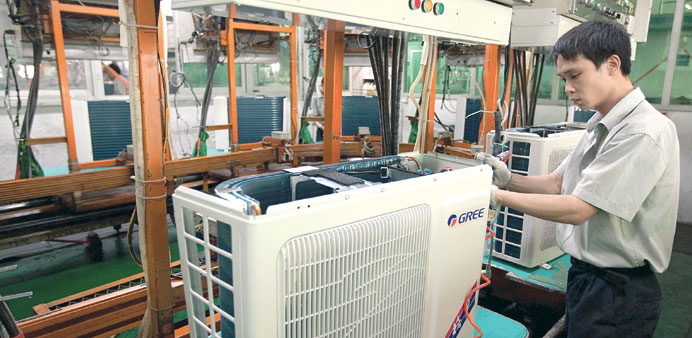|
|
Asia’s factory sector lost momentum in May as new export orders in the trading bellwethers of China, Taiwan and South Korea fell or cooled, reinforcing the view that the world economic outlook is dimming in the second quarter.
The HSBC China purchasing managers’ index (PMI) fell in May to 49.2, the lowest level since October 2012 and down from April’s final reading of 50.4. A reading below 50 suggests a contraction in activity from the previous month, while a reading above that level points to expansion.
The China survey showed that total new orders and new export orders fell in May from April, suggesting weakness in both domestic and overseas demand.
New export orders also fell in Taiwan, a key producer in the global technology supply chain, while in South Korea, home to big brand names such as Samsung and Hyundai, new export orders growth eased to its weakest pace since January, the HSBC surveys showed.
“A number of respondents blamed the reduction in demand to a general slowdown in global activity,” HSBC said of the Taiwan PMI.
“The global economy remains weak... There’s nothing in the system at the moment, certainly in China, that suggests there is a big pick-up in store just around the corner,” said Victoria Clarke at Investec.
The HSBC PMI followed a similar government survey released on Saturday that showed a slight uptick but also pointed to falling orders from important export markets.
“We think China’s economic growth will probably continue to slide,” said Zhiwei Zhang, chief China economist at Nomura in Hong Kong.
New export orders also fell in Taiwan, a key producer in the global technology supply chain, while in South Korea, home to big brand names such as Samsung and Hyundai, new export orders growth eased to the weakest pace since January.
“A number of respondents blamed the reduction in demand on a general slowdown in global activity,” HSBC said.
Growth in Indian factories was close to stalling, with the HSBC PMI slipping to its lowest reading since March 2009, although the index has stayed above the 50 mark separating expansion from contraction for over four years.
For the eurozone, Markit’s PMI rose to 48.3 from April’s 46.7 but spent its 22nd month below the watershed 50 level that marks contraction. Still, it was its highest since February 2012 and the first time the downturn has eased in four months.
The PMI for Germany, Europe’s largest economy, remained sub-50 but did improve and it was a similar story in neighbouring France, the bloc’s second biggest economy. Spanish and Italy’s PMIs behaved similarly.
British manufacturing, however, expanded at its fastest pace in over a year last month, boosting optimism that the country’s recovery is becoming more broad based.
An upward revision to April meant British factories have now expanded for two straight months.
Figures expected later yesterday from the US are expected to do little to lift the gloom. The US Institute for Supply Management PMI is seen slightly above 50, while a eurozone PMI is seen showing the region’s manufacturing activity contracting again.
Last week, the Organisation for Economic Co-operation and Development cut its global growth forecast for 2013 to 3.1% from its previous estimate of 3.4%.
China’s HSBC PMI followed a similar government survey released on Saturday, which showed a slight pullback to 50.8 in May from 50.6 in April. However, it also pointed to falling orders from exports markets.
The data, plus a fall in the official services PMI to 54.3 from 54.5, added to evidence that the world’s second-largest economy is losing further momentum in the second quarter.
“We think China’s economic growth will probably continue to slide,” said Zhiwei Zhang, chief China economist at Nomura in Hong Kong. “Our forecast of GDP growth in Q2 is to slow to 7.5% from 7.7% in Q1.”
The IMF and OECD last week cut their forecasts for 2013 economic growth to 7.75% and 7.8%, respectively.
China’s annual economic growth slowed to 7.7% in the first quarter from 7.9% in the previous quarter. The full-year annual growth of 7.8% in 2012 was the weakest since 1999.
The IMF’s cut brings it into line with recent revisions by private institutions, including Bank of America-Merrill Lynch, which pared its forecast this month to 7.6% from 8%, and Standard Chartered, which cut its estimate to 7.7% from 8.3%.
ING last month reduced its prediction to 7.8% from 9%.
Growth in India’s factory sector activity was close to stalling, with the HSBC PMI slipping to 50.1 in May from 51.0 in April. It marked the lowest reading since March 2009, although the index has stayed above 50 for over four years.
However, a factory production sub-index showed output was falling for the first time in more than four years as new orders growth slowed to a trickle.
“Economic activity in the manufacturing sector slowed further in May as output contracted in response to softer domestic orders,” said Leif Eskesen, an HSBC economist, adding that power outages had contributed to the drop in output.
Taiwan’s PMI fell to 47.1 in May from 50.7 in April, the first time the index has fallen below 50 since November.
South Korea’s PMI fell to 51.1 from 52.6 for the weakest reading since February.
Russia’s manufacturing activity was the weakest in five months, with the PMI falling to 50.4 in May from 50.6 in April.

